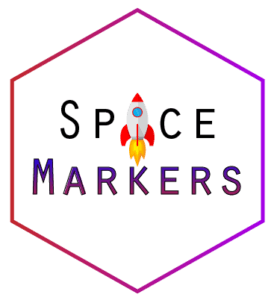Research
Development of a tumor forecast system for cancer interception
The revolution in technologies provides the opportunity to uncover hundreds of cancer proteins that interact with normal cells. These large datasets require new data science methods to interpret them into clinically actionable information.
 A team led by Dr. Elana Fertig has developed new artificial intelligence methods and protocols that enable us to monitor immune cell response in spatial-transcriptomics and spatial proteomics technologies. These techniques are being adapted across NCI research projects through the Informatics Technologies in Cancer Research Consortium and other National Consortia. A postdoctoral fellow in the Fertig Lab, Dr. Atul Desphande, developed the new SpaceMarkers approach to discover communication networks between tumor and immune cells. The new knowledge gained about tumor biology from these computational methods are now enabling us to adapt the mathematics of chaos theory employed for weather forecasting to tumor biology. These mathematical approaches will enable us to predict the impact of new cancer therapies, providing new methods to perform clinical trials computationally.
A team led by Dr. Elana Fertig has developed new artificial intelligence methods and protocols that enable us to monitor immune cell response in spatial-transcriptomics and spatial proteomics technologies. These techniques are being adapted across NCI research projects through the Informatics Technologies in Cancer Research Consortium and other National Consortia. A postdoctoral fellow in the Fertig Lab, Dr. Atul Desphande, developed the new SpaceMarkers approach to discover communication networks between tumor and immune cells. The new knowledge gained about tumor biology from these computational methods are now enabling us to adapt the mathematics of chaos theory employed for weather forecasting to tumor biology. These mathematical approaches will enable us to predict the impact of new cancer therapies, providing new methods to perform clinical trials computationally.
Patient avatars for therapeutic selection

Patient-derived organoids are 3-dimensional cell cultures created from each patient’s cancer cells that can be used to examine specific characteristics of a patient’s tumor. Dr. Jackie Zimmerman and Dr. Richard Burkhart have developed methods to co-culture tumor cells and their surrounding normal cells, such as fibroblasts and immune cells, to create a model for testing new drugs to individualize treatment that will most benefit each patient. In collaboration with the Department of Pathology, this discovery work is now being adapted for testing patient tumors for drug sensitivity in clinical trials.
Mapping the complex interactions of tumor cells with normal cells that grow around them
 Through collaborations with genomics and proteomic technology companies, we are advancing state of the art single-cell technologies and spatial molecular technologies to uncover the function of cells in the tumor at new scales. The Convergence Institute uses these technologies as part of standard practice in our clinical trials. This research enables us to uncover biomarkers to predict the effect of new therapeutic strategies and to discover new targets for drug development. Our leadership’s translation of these technologies to the clinic is recognized by national consortia. For example, Dr. Luciane Kagohara was selected participate in 10X Genomics’ Clinical Translation Research Network for translational applications of spatial transcriptomics; and Dr. Robert Anders leads a nation-wide working group to adapt the CODEX (CO Detection by Indexing) spatial proteomics technology for translational research. We are also broadly disseminating these technologies to the greater Johns Hopkins University community through founding a new cancer center shared resource led by Dr. Won Jin Ho. This shared resource provides single-cell and spatial proteomics using Mass Cytometry (CyTOF) and Imaging Mass Cytometry (IMC) at scale to investigators conducting both laboratory and clinical research.
Through collaborations with genomics and proteomic technology companies, we are advancing state of the art single-cell technologies and spatial molecular technologies to uncover the function of cells in the tumor at new scales. The Convergence Institute uses these technologies as part of standard practice in our clinical trials. This research enables us to uncover biomarkers to predict the effect of new therapeutic strategies and to discover new targets for drug development. Our leadership’s translation of these technologies to the clinic is recognized by national consortia. For example, Dr. Luciane Kagohara was selected participate in 10X Genomics’ Clinical Translation Research Network for translational applications of spatial transcriptomics; and Dr. Robert Anders leads a nation-wide working group to adapt the CODEX (CO Detection by Indexing) spatial proteomics technology for translational research. We are also broadly disseminating these technologies to the greater Johns Hopkins University community through founding a new cancer center shared resource led by Dr. Won Jin Ho. This shared resource provides single-cell and spatial proteomics using Mass Cytometry (CyTOF) and Imaging Mass Cytometry (IMC) at scale to investigators conducting both laboratory and clinical research.
Personalized Vaccines


Drs. Elizabeth Jaffee and Neeha Zaidi are working to use genetic data from patient tumors to identify specific proteins unique to a patient’s cancer, called neoantigens, that can be used to produce patient specific vaccines for cancer treatment and cancer prevention. Their clinical trial testing a vaccine containing mutated KRAS peptides in individuals at risk for pancreatic cancer who inherited a cancer-causing gene mutation, or have family history of disease, was recently featured by Science. When a person develops pancreatic cancer, one of the first genes to mutate is KRAS. KRAS is present in 90% of advanced pancreatic cancers. This vaccine instructs the body’s immune system to attack and suppress the production of KRAS, with the goal of stopping cancer progression or preventing disease in high-risk individuals.
